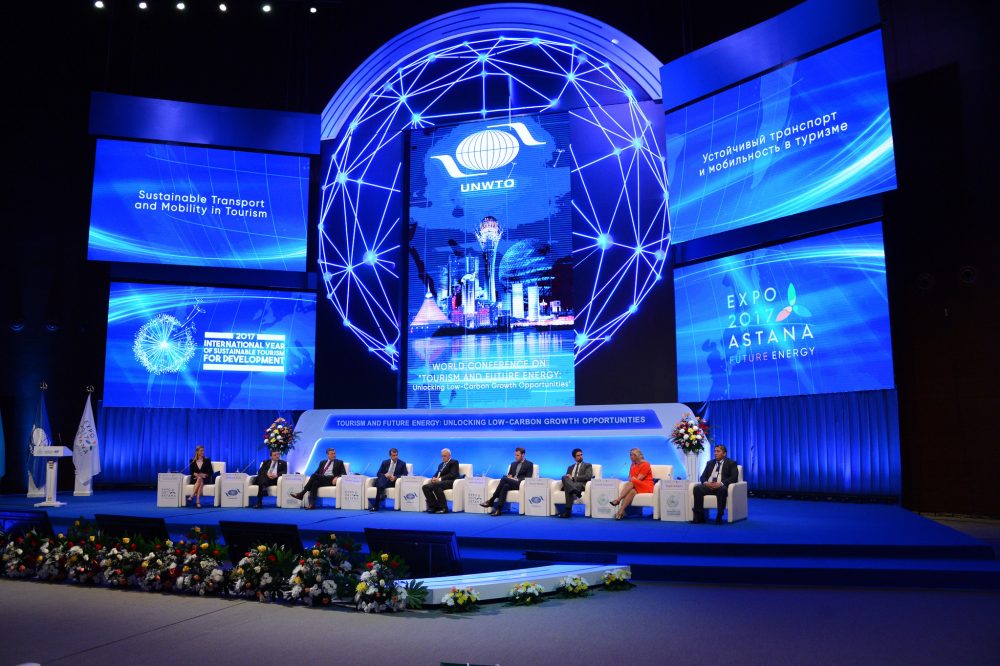Travel and Tourism is without a doubt one of the most successful and fastest changing industries. In many countries travel has now become such an integral component of life and business that many systems (including global family structures) would stop to function in the absence of global transport systems. Further and thanks to the sharing economy tourism has become interwoven with everyday activities of even those who do not travel themselves.
This phenomenal and pervasive boom comes at a high environmental cost. Tourism is knowingly a major consumer of energy and contributor to global climate change, in particular its transport component which alone makes up about 75% of tourism’s global carbon footprint. With annual growth rates of about 5% it is difficult to imagine a substantial reduction in carbon emissions from tourism – unless the tourism industry can participate in, or catalyse a major energy revolution that rapidly transforms current system through low carbon energy technologies. The UNWTO World Conference on ‘Tourism and Future Energy: Unlocking low-carbon growth opportunities’, recently held as part of the Expo Astana, explored some of these opportunities.
The prospects of an energy revolution are very different for the various parts that make up the ‘tourism product’. For tourist accommodation, for example, a number of ‘mainstream’ technologies exist and several projects have produced toolkits (e.g.nearly zero energy hotels, neZEH) or informative case studies (e.g. Relacs, 2013). Common options include solar hot water installations, photovoltaic, use of biomass, and passive building design. Despite being available, their penetration is still low – well known barriers persist, such as traditional thinking by developers and architects, higher upfront capital cost, lack of detailed knowledge on alternative options, and so on. The use of renewable energy applications at this points often depends on favourable agreements with grid providers (e.g. feed in tariffs), but fast progress in terms of battery storage could change the appeal of energy self-sufficiency rapidly. At this point, however, only very few tourism businesses have gone completely off-grid. One prominent example is Lady Elliot Island in the Southern Great Barrier Reef, Australia. Clearly, if tourist accommodation wants to make a meaningful contribution to science- based targets that are in line with the carbon reduction demands articulated in the Paris Agreement, immediate acceleration of renewable energy uptake is imperative.
Transformative change in the design and technologies of electric cars and buses – and maybe more importantly public acceptance of electric vehicles – has been considerable in recent years and taken some by surprise. The year 2016 saw over one million electric cars on the road. In addition to technological progress in battery technology, the accelerated uptake has been strongly facilitated by favourable policies in a few countries, such as Norway. These progressive countries have catalysed the ‘mainstreaming’ process, which is now slowly permeating other parts of the world. To date there is limited systematic uptake of electric vehicles in tourism company fleets (e.g., see Air New Zealand), but there are examples of initiatives that help accelerate the use of electric cars, for example through preferential corporate taxi services delivered by electric vehicles in Stockholm, Sweden.
Water transport is an important form of tourist transportation, and there is some exciting progress happening in this space. Whilst most vessels run on diesel the possibility of going carbon-zero has been demonstrated by Soel yachts. The purpose-built, and ocean-fit catamaran type vessel uses ultra-thin and lightweight ocean proof solar panels in combination with batteries that store enough power to provide propulsion for eight hours even in the absence of sun (or feed back into the micro- grid of a tourist resort!). The boat is soon beginning operations in Bora Bora (Tahiti) and should set an example for any other marine-based tourism operation that seeks low carbon (and nature-based tourism options. Cost is an issue at present, but hopefully the combination of eco-innovation, attractive design and luxury (island) destinations will attract enough investors to accelerate the cost curve and make zero-carbon water transport the norm. Renewable energy technologies also need to reach the fast growing cruise ship industry.

Aviation is the most challenging sub-sector of travel and tourism in terms of achieving zero-carbon growth. An energy revolution appears to be decades away. Whilst the use of biofuels (typically blended with aviation fuel) is technologically proven, large-scale implementation seems unlikely due to costs, questions surrounding the sustainability of the fuel stock, and the sheer volume of biofuel required for the global fleet. Other options include electric/solar planes (challenged by the ratio of energy density versus weight), hydrogen-planes, or hybrid-electric planes using superconductors. Research is underway on all these fronts, but progress is slow. For aviation, the near term prospect seems to be continuous incremental improvements in efficiency, demand management and the purchase of carbon offsets (which in themselves raise numerous questions and challenges).
In summary, the investment in, and uptake of renewable energy technologies in tourism is patchy. Some technologies could be mainstreamed faster than others, but for all of them it seems that greater collective commitment to low-carbon tourism is required to accelerate change. Important next steps are to increase the number of demonstration projects, drive down costs, create ‘new norms’, shape customer perceptions, and develop supportive policy frameworks (e.g. regulatory incentives, price signals). The outcome of concerted effort will not only be a reduction in tourism’s carbon footprint but an affirmation of the sector’s ‘social license to operate, which will be increasingly under scrutiny in a decarbonising world.
Written by Susanne Becken, Professor of Sustainable Tourism, Griffith University
